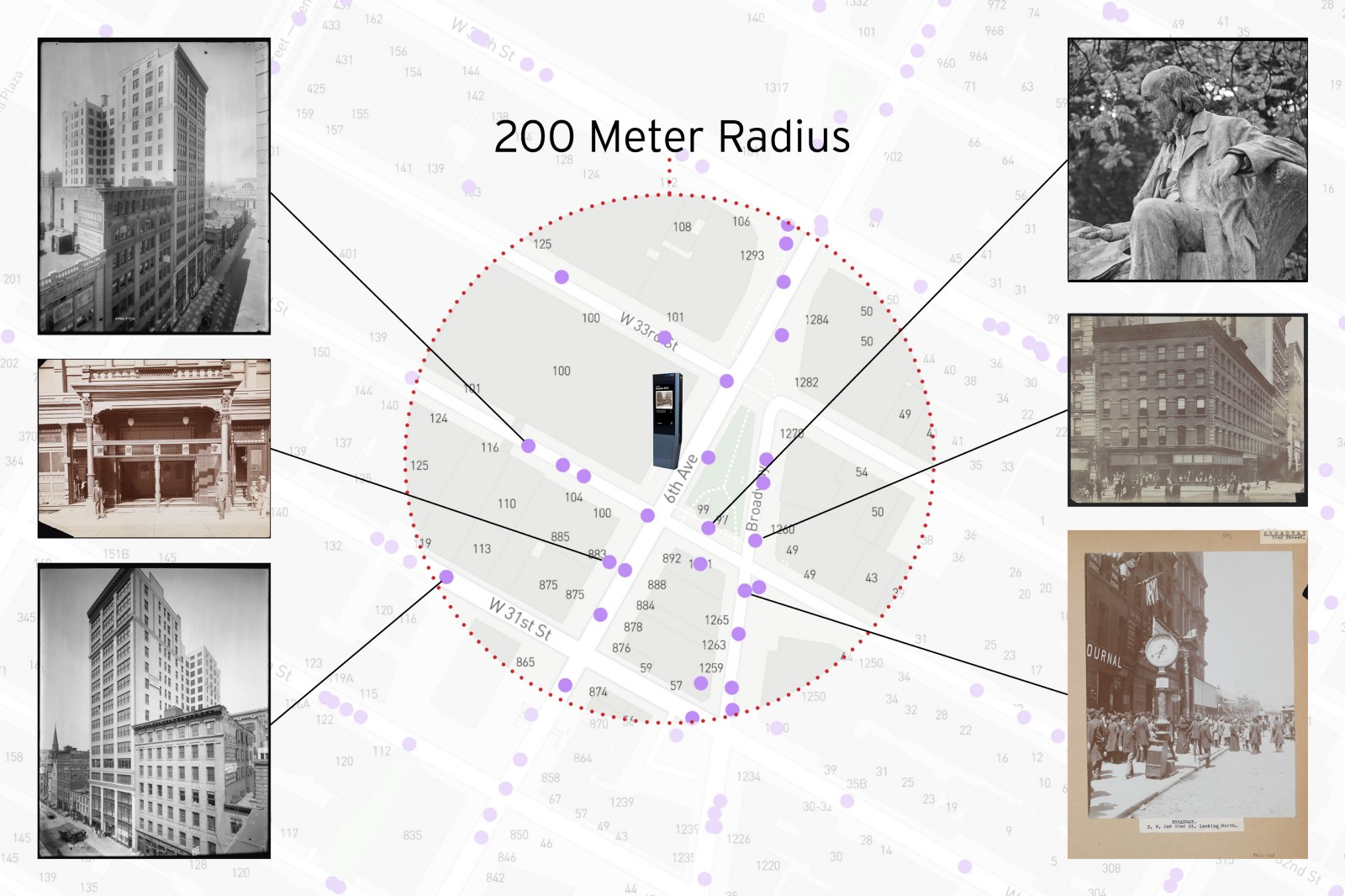Across New York City you’ll find the ubiquitous public telephone booth. While some are still in use and others are out of order, the booths remain a physical reminder of the past. A Google search while writing this article revealed that there are just four functional telephone booths left in NYC. Arts and cultural organizations are finding new ways to use the booths located high traffic areas where these public pay phones once stood. Urban Archive is turning these spaces into digital kiosks to connect people to the history that surrounds them, turning New York City sidewalks into a museum space. 
How Does it Work?
Urban Archive began as a mobile app that connected users to digital images shared through the archives of historic sites, taking an active role to promote the stories and images provided by museums. The location-based app brings together digital collections from New York City’s museums, archives, and libraries for users to discover and learn about history at the places it happened. Urban Archive partners with organizations that have digitized their collections and then takes those files and uploads them onto their content management system that gives each partner organization access. 
Multiple screenshots of the app interface.
“The City is Your Museum”
In 2016, Urban Archive founders Ben Smyth and Tim Bradley had an idea to engage visitors with an immersive storytelling experience that extended beyond the museum walls. With over 80,000 photos gathered from across New York City since its founding, the Urban Archive app matches historic images to their locations on an interactive map of the city. The founders’ vision for the app was ”The City is Your Museum” and to achieve their goal they knew they had to ask museums and cultural institutions to share their digital archives with the public. The resulting Urban Archive app relies on the community and fosters partnerships with cultural institutions to inspire users to learn more about architecture, culture, and unique stories of New York City.
There are passive and active ways to engage with the app. Users can view the NYC map to see historical images and explore stories at their leisure. The app can also send push notification alerts with the historical fact of the day, or when you are near a historic place that has an image and story. At the top of the app screen are “Featured Stories” for users to explore at their own pace. This app uses data mapping technology to connect locations around New York City to images and stories within their specific location. People can also interact with Urban Archive without a smartphone in New York City.

A LinkNYC Kiosk where a former payphone once stood now showing historical images from the Museum of the City of New York.

Diagram from Urban Archive illustrating how these kiosks work.
Kiosks = City’s Virtual Museum
Urban Archive partnered with LinkNYC to create more than 1,800 digital kiosks in all five boroughs. LinkNYC started in 2016 as a way to replace outdated payphones with free wi-fi, phone calls, device charging, city maps and other connectivity access for contemporary New Yorkers. Working with the Museum of the City of New York, these kiosks now include historic images that show passerbys what that street looked like years ago. On your way to work on Orchard Street on the Lower East Side? See photographs of 19th century immigrant street vendors who set up their carts to sell their goods. These kiosks synchronize the mapping technology data with the LinkNYC system and are location-based so the photos that appear are pulled from a 200 meter radius of the kiosk.
“This mapping technology creates an exciting new way for New Yorkers and visitors to see historic photography of the streets they’re walking on just by passing a LinkNYC kiosk,” said Samir Saini, Commissioner of the Department of Information Technology and Telecommunications in a press release. “With an expansive five-borough network, LinkNYC is giving New Yorkers and visitors alike the ability to travel back in time with historic photography of the neighborhoods where we live, work and visit. Thanks to the rich archive and mapping technology from the Museum of the City of New York and Urban Archive, we are providing a way for all of us to feel more connected to the city and its history,” said Ruth Fasoldt, Link’s Director of External Affairs.
These kiosks primarily use images from the Museum of the City of New York, but Urban Archive launched “My Archive” to tell the story of New York City residents by crowdsourcing their histories and photographs. During certain months, like this past February and June, people submitted their photos for a chance to have them added to a personal history collection included on Urban Archive. These personal and unique photographs and stories from the people of New York add voices to the historical narrative that might not be included in traditional archives.
In June, 25 stories and images were chosen from submissions that were highlighted on the mobile app as well as featured in the digital kiosks in proximity to where photographs were originally taken. “My Archive” connects the people of New York City to these historic archival photographs with personal stories, making their city their museum.
MANY Executive Director Erika Sanger submitted one of her father outside McSorley’s Old Ale House in 1958 c and her mother in front of the Metropolitan Museum of Art in 1962.
Power in Partnership
“Urban Archive moves collections into a more collaborative setting that provides a platform for partners to collaborate, share information, and share content for programming and exhibitions,” said Sam Addeo, Urban Archive Director of Community and Development. At its start, Urban Archive engaged partners directly pitching the app to museums and cultural organizations. Establishing trust with these organizations was essential. Urban Archive is not a one time use app. It is a free tool to help strengthen these institutions, to connect institutions to one another's digital archive, and to focus on promoting these partner institutions. App partners grew from the Brooklyn Historical Society to include: Museum at Eldridge Street, Museum of Contemporary Art (MOCA), Museum of the City of New York, NYC Department of Records, New-York Historical Society, New York Public Library, South Street Seaport Museum, Green-Wood Cemetery, The Municipal Art Society of New York, Fire Museum, The Skyscraper Museum, the Alice Austin House, Bronx Historical Society, Brooklyn Public Library, Historic House Trust, the New York Transit Museum, and the Museum of Chinese in America just to name a few.
Extended Museum Visit
The “City Stories” app feature on Urban Archive utilizes museums’ digital collections to bring their visitors beyond the museums doors to historical sites. These “City Stories” provide digital imagery to illustrate museums stories and bring you to the location where it happened. Did you read about the “Eagle Pencil Strike of 1938” at the New-York Historical Society? Visit East 14th Street and see the strike location in person using this feature. Stories created by the Museum of the City of New York offer new content weekly as well as their new exhibitions and walking tours.
Audio guides are the other initiative to expand the museum visit with the app. Urban Archive developed the technology for these audio guides and their mission is to “democratize this technology, making audio guides accessible to all.” It gives the creative power to the institutions to build custom tours both inside and outside of museums and in the communities where the stories originated.
App Expansion Upstate
In June, Urban Archive expanded from New York City to Newburgh, NY as organizations in the Hudson Valley start to make their photographic collection accessible to the public using the digital platform. Five partners have joined Urban Archive in this expansion and have uploaded more than 148 images of historic Newburgh for the public to explore.
What Can Your Museum Learn from Urban Archive?
Sharing resources and cross-promoting information between museums can further enrich their programming and exhibitions. “Look at the tools available and find an open data software...it doesn’t have to be high tech, and start digitizing your collection and share it,” Sam Addeo said. “Small institutions can work with larger ones to share information and share content. A smaller institution might have content that a larger institution is looking for to help tell a story.” Museums that share resources and collections make stories accessible and contextualize history to create a meaningful experience in the communities they serve.
